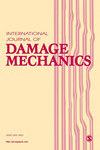Multi-scale study on the fatigue mechanical properties and energy laws of thermal-damage granite under fatigue loading
IF 3.9
2区 工程技术
Q2 MATERIALS SCIENCE, MULTIDISCIPLINARY
引用次数: 0
Abstract
To reveal the mechanical properties and energy laws of high-temperature rock mass engineering under fatigue disturbance, this paper conducted a multi-scale study on thermally damaged granite. First, the macroscopic mechanical properties of the samples were studied. Secondly, the law of energy evolution was summarized based on thermodynamic theory. Then, a rockburst index was introduced, and NMR and SEM technologies were used to conduct a multi-scale discussion on the mechanism of influence on temperature. Finally, an improved nonlinear continuous damage model (INCDM) was established, and a hardening index and damage growth rate of low-cycle fatigue were defined. The result shows that temperature first strengthens and then weakens the fatigue mechanical properties of the sample, with a threshold temperature of 225°C. Temperatures below the threshold cause uneven expansion of mineral particles to squeeze natural pores, reduce the porosity of the sample, and thus increase the fatigue life and strength of the sample. Temperatures above the threshold cause dehydration and phase change of the minerals such as quartz, feldspar, and mica, forming transgranular/intergranular cracks, parallel cleavage and stratification, thus reducing the fatigue strength of the sample. In addition, the total energy, elastic energy and dissipated energy density of the sample all show a step-like increasing trend with the normalized cycle index. Energy storage satisfies a linear law. Affected by accelerated energy release, energy dissipation changes from linear to nonlinear law. As the temperature increases, the rockburst tendency first increases and then decreases. The fatigue failure changes from sudden instability to progressive instability mode. The fatigue-thermal damage of the sample satisfies a power law, and increases as a compound power function with the normalized cycle index.疲劳加载下热损伤花岗岩的疲劳力学性能和能量规律的多尺度研究
为了揭示疲劳扰动下高温岩体工程的力学特性和能量规律,本文对热损伤花岗岩进行了多尺度研究。首先,研究了样品的宏观力学性能。其次,根据热力学理论总结了能量演化规律。然后,引入了岩爆指数,并利用核磁共振和扫描电镜技术对温度的影响机制进行了多尺度讨论。最后,建立了改进的非线性连续损伤模型(INCDM),并定义了低循环疲劳的硬化指数和损伤增长率。结果表明,温度先增强后削弱样品的疲劳机械性能,阈值温度为 225°C。低于临界温度会导致矿物颗粒不均匀膨胀,挤压天然孔隙,降低样品的孔隙率,从而提高样品的疲劳寿命和强度。温度高于临界值会导致石英、长石和云母等矿物脱水和相变,形成晶间裂缝、平行劈裂和分层,从而降低样品的疲劳强度。此外,试样的总能量、弹性能量和耗散能量密度均随归一化循环指数呈阶梯状上升趋势。能量存储满足线性规律。受加速能量释放的影响,能量耗散从线性规律变为非线性规律。随着温度的升高,岩爆倾向先增大后减小。疲劳破坏由突然失稳转变为渐进失稳模式。试样的疲劳-热损伤符合幂律,并随归一化循环指数的增加而呈复合幂函数增加。
本文章由计算机程序翻译,如有差异,请以英文原文为准。
求助全文
约1分钟内获得全文
求助全文
来源期刊

International Journal of Damage Mechanics
工程技术-材料科学:综合
CiteScore
8.70
自引率
26.20%
发文量
48
审稿时长
5.4 months
期刊介绍:
Featuring original, peer-reviewed papers by leading specialists from around the world, the International Journal of Damage Mechanics covers new developments in the science and engineering of fracture and damage mechanics.
Devoted to the prompt publication of original papers reporting the results of experimental or theoretical work on any aspect of research in the mechanics of fracture and damage assessment, the journal provides an effective mechanism to disseminate information not only within the research community but also between the reseach laboratory and industrial design department.
The journal also promotes and contributes to development of the concept of damage mechanics. This journal is a member of the Committee on Publication Ethics (COPE).
 求助内容:
求助内容: 应助结果提醒方式:
应助结果提醒方式:


